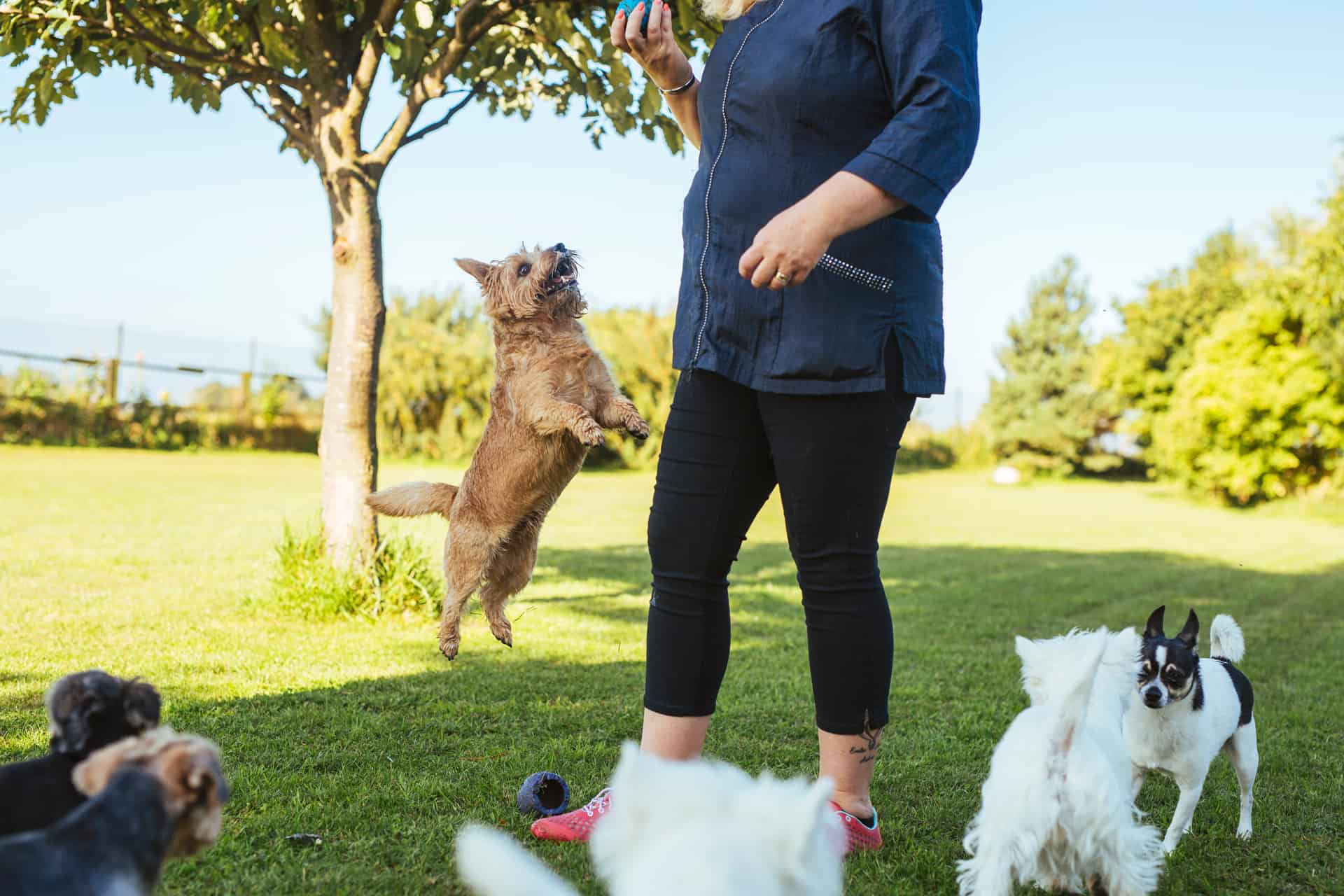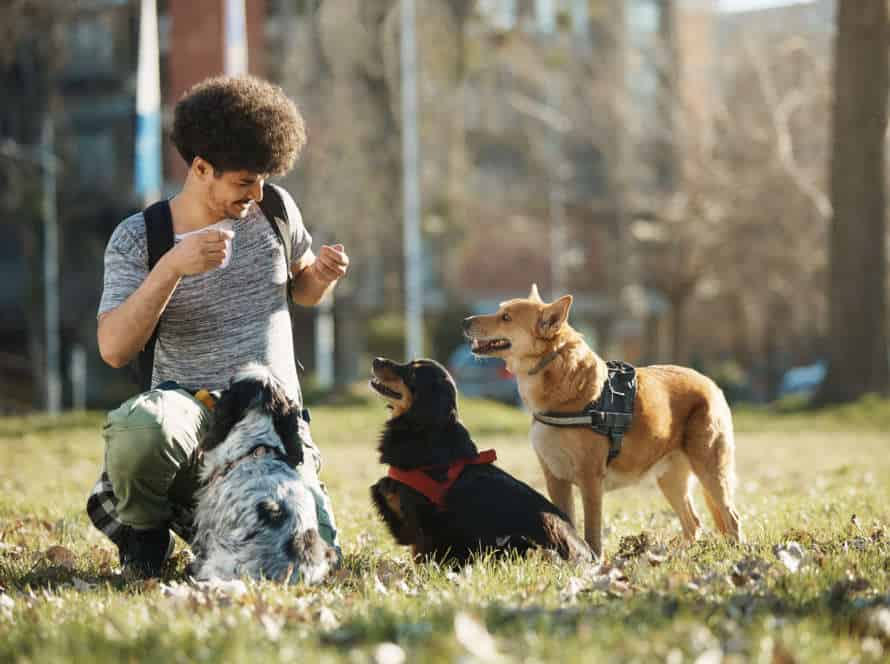How Breed Influences Training: What to Expect
Dog breeds differ in the way they learn and react to commands. Knowing how breed affects training can help you adjust your teaching techniques, to get better outcomes with your pup.
For example:
- Herding Breeds – Border Collies and Australian Shepherds are clever and easy to train. These breeds have immense work ethics and respond well to routines that activate their intelligence and strength.
- Hunting Breeds – Labradors and Golden Retrievers are enthused by food and play rewards. They are willing to learn and eager to make their owners happy.
- Guard Breeds – Rottweilers and Mastiffs are territorial and can be aggressive. They require frequent socialization and firm instruction to control their aggressive behavior.
- Small Breeds – Chihuahuas and Pomeranians are thought to be stubborn and hard to teach. They need disciplined and regular instruction that uses positive reinforcement and reward-based teaching.
Knowing how breed affects training is the initial step towards forming a solid bond with your pup, and improving training results.
Understanding Your Dog’s Breed
Breeds of dogs can really affect how well training goes. Different types of dogs have varying skills and traits that must be considered when making a training plan. This article discusses all the elements to consider when choosing a breed for training, as well as how it affects your plan and expectations.
Behavioral Characteristics of Different Breeds
Knowing the habits of different dog breeds is important for training them right and being a great pet owner. Here are some common traits of well-known breeds:
- Labrador Retriever: Friendly, energetic, and loves to please.
- German Shepherd: Loyal and protective, with a high prey drive. Needs lots of exercise and mental stimulation.
- Beagle: Smart, lively, and loving. Tends to bark and has a good sense of smell.
- Poodle: Smart, graceful, and adaptable. Has hypoallergenic fur and lots of energy.
- Bulldog: Sweet and gentle. Has a calm nature and may snore and drool.
Understanding your pup’s specific behaviors can help you adjust your training methods, build a strong bond, and have a healthy relationship.
How Breed Can Affect Learning Speed and Method
Comprehending your dog’s breed and the effect it has on their learning speed and approach can be significant in training your furry buddy successfully.
Dogs have been selectively bred for particular characteristics and purposes, which can affect how they learn and respond to instruction. For instance:
- Herding breeds like Border Collies and Australian Shepherds have an innate urgency to control the behavior of other animals and can grasp obedience and agility training quickly.
- Hound breeds, such as Basset Hounds and Beagles, were initially bred for hunting and may have a powerful sense of smell and independent thinking, impacting their capability to respond to teaching.
- Terriers, such as Jack Russell Terriers and Rat Terriers, were bred to hunt rodents and may have high energy levels and a strong hunting drive, making them more difficult to train.
It is essential to study and understand your dog’s breed traits to devise effective training techniques that suit their individual learning style.
Pro tip: Positive reinforcement methods and patience can support in overcoming some of the obstacles that breed-specific traits may bring up during training.
Popular Breeds and Their Optimal Training Style
Knowing your pup’s breed is key to finding the right training style. Different breeds have diverse temperaments, energy levels, and instincts that can sway their actions and reply to training. Here are some of the most popular dog breeds and their training approach:
- Labrador Retriever – These friendly, active dogs excel with positive reinforcement training such as clicker training and reward-based methods. They are very trainable and love pleasing their owners.
- German Shepherd – Smart and protective, German Shepherds need firm, consistent training from a young age. Reward-based training is best, as they have a strong prey drive and can become aggressive without proper training.
- Poodle – Very intelligent and trainable, Poodles need mental stimulation for training. Positive reinforcement works well for them and they enjoy learning new tricks and tasks.
- Beagle – Independent and stubborn, Beagles need patience and persistence for training. Food-based training works best, like using treats to reward good behaviour.
- Bulldog – With a laid-back personality, Bulldogs respond well to positive reinforcement training. Short and consistent sessions are best, as they easily lose focus.
Knowing your pup’s breed and the optimal training style can help you effectively train them and build a strong bond.
Training Methods Based on Breed
It is essential to comprehend the breed you’re training when teaching them. To do this, let’s explore various breeds and their preferred training methods. Knowing a breed’s temperament and what it naturally likes can be a great help in training.
Positive Reinforcement Training for People-Oriented Breeds
Positive reinforcement training is a widely-used, effective way to train people-oriented dog breeds. These breeds usually love to please their owners and react well to reward-based training. Here are some tips:
- Don’t use punishment-based training – it can lead to fear and aggression.
- Use positive reinforcement techniques like clicker training and reward-based training to encourage good behaviour.
- Use high-value treats such as boiled chicken, hot dogs, or cheese as rewards to keep your dog motivated.
- Keep training sessions short, fun, and engaging.
- Be consistent and patient with your training to get the best results.
Pro tip: Every dog is unique, so tailor your training to suit your dog’s personality and needs, regardless of breed.
The Importance of Praise and Treats
Praise and treats are must-haves when it comes to training a pup. Positive reinforcement is the way to go, which will help build a strong connection between the dog and its owner.
Encourage behaviors like sitting or staying by praising your pup. Treats can also be used as a reward, but pick healthy, low-calorie options so as not to overfeed.
Different breeds have different behaviors and learning styles. Some require more patience and persistence while others are faster to please and react better to positive feedback.
No matter what breed, success in dog training boils down to consistency, patience, and positive reinforcement.
The Use of Clickers in Training
Clicker training is a positive reinforcement technique that teaches canines to link the sound of a clicker with rewards and praise. This method is great for training all types of dogs, as it allows trainers to tailor the training to the pup’s individual learning style.
For instance:
- Terriers: They are known for their high-energy and stubbornness. Clicker training helps them focus on particular behaviours and curbs their tendency to be easily sidetracked or uninterested.
- Retrievers: They are praised for their eagerness to please and willingness to learn. Clicker training reinforces their good actions and encourages them to learn new commands and tricks.
- Bulldogs: They can be hard to train due to their independent nature. Clicker training helps them to become more responsive to their owners and improves their general behaviour.
By combining clicker training with breed-specific methods, trainers can help all kinds of dogs learn new behaviours and turn into obedient and well-behaved pets.
Environmental Training for Independent Breeds
Training independent breeds is essential. Huskies, Beagles and Basenjis all require unique training techniques, taking their breed traits into account.
For Huskies, keep their active nature in mind. Involve physical exercise, to avoid monotony and provide mental stimulation.
Beagles have a strong sense of smell, so use this as a training tool and include daily exercise.
Basenjis are an ancient breed, with a high prey drive. Training them requires firmness and consistency to control their impulsive behaviors.
Training should be tailored to each dog’s breed characteristics.
Use of Chew Toys and Interactive Puzzles
Different pooches need various training techniques to be efficiently trained. Chew toys and interactive puzzles are a successful way to train your pup, but it’s even more important to consider the breed before using these methods.
For instance, chew toys can be useful for most breeds, but they’re a must-have for those that are known chewers or have high energy. Plus, puzzles can help stimulate the minds of intelligent breeds, such as Border Collies. Not as much for breeds that are not as clever.
Comprehending how breed impacts training is essential for successful pup training. It affects everything from the techniques used to the amount of time it takes for your pup to learn a behavior.
Pro tip: Always research your dog’s breed before adopting him to get a clearer idea of which training methods work best for him.
Training in Different Environments
When training dogs, their breed and environment play a role. For example, Border Collies and German Shepherds are very trainable and good at obedience and agility. They need lots of mental and physical exercise to stay motivated and out of trouble. Bichon Frises and Bulldogs, however, require different training methods, like positive reinforcement and patience.
Think about your pup’s breed and traits when making a plan. Be consistent and patient. Also, take them to different places – parks, beaches, indoors – so they can follow commands and behave in any situation.
Firm-Control Training for Territorial Breeds
Firm-control training is essential for territorial breeds like the Rottweiler, German Shepherd, and Doberman Pinscher. Owners must set boundaries and structure through consistent training. Here are successful methods:
- Positive Reinforcement Training: Reward good behavior with praise, treats, or a toy. This method has been found to reduce bad behaviors and boost obedience.
- Socialization Training: Introduce your pup to people and animals from an early age. This can help curb territorial behavior and aggression towards strangers. It can include puppy classes, playdates, and supervised encounters with other dogs.
- Obedience Training: Commands like “sit,” “stay,” and “come” are key for these types of breeds. Obedience training can also strengthen the bond between you and your pup, especially breeds that tend to be aggressive.
Remember, each breed has its own personality and needs. Knowing breed-specific traits and tendencies can help you prepare for challenges and train your dog more effectively.
Proper Leash Handling and Training
Leash handling and training are a must for your dog’s safety and happiness in the outside world.
First step: purchase the right leash and collar, making sure it fits properly. Breeds can impact training methods. Get to know yours – retrievers like to play and need lots of exercise, so use games during training. Hounds have a great sense of smell and need to learn the “come” command, especially when they scent something.
Leadership is key when training your pup. Be consistent, clear and use positive reinforcement. Reward your doggie when they obey commands and redirect their behaviour when needed. Every dog is special, so different training methods may work better. Seek professional help if you’re stuck or want to know more breed-specific needs.
Avoiding Triggers and Aggressive Situations
To prevent aggressive behavior in dogs, it is important to avoid triggers and aggressive situations during training. Different breeds of dogs react differently to triggers and stimuli. Here are some ways to do this:
- Identify what your dog’s triggers are, such as other dogs, strangers, or loud noises.
- Use a positive, reward-based training method, like clicker training, to build trust and boost your pup’s confidence.
- Expose your pup gradually to its triggers in a safe and controlled setting.
- Redirect its attention away from the triggers with toys or treats to promote positive behavior.
- If your pup shows excessive aggression, seek help from a professional dog trainer or behaviorist.
Remember, understanding the breed-specific traits and training needs of your dog is key for successful training.
Common Challenges for Specific Breeds
Dogs are varied. So, each breed has its own challenges in training. Character traits or physical abilities may make certain tasks tricky. Knowing the common challenges for a breed helps you plan training. Therefore, better training!
Common Challenges in Training Retrievers and Spaniels
Retrievers and spaniels can be tricky to train, due to breed-specific traits. Retrievers, like Labradors and Golden Retrievers, are easy to coach. They’re energetic and love to please. But, this same enthusiasm can be hard to manage if not trained properly.
Cocker and Springer Spaniels are more independent and headstrong. Training can be a challenge! They also have a strong prey drive, which can be tough to recall when they’ve got a scent.
When training either breed, consider their unique qualities. Set clear limits and use lots of positive reinforcement for best results.
Over-Excitement for Birds and Toys
Certain breeds have a common struggle during training: getting too excited about birds and toys. Retrievers and spaniels, bred to hunt and retrieve, are especially prone. To manage this, pick a toy that suits your dog’s breed and character. For retrievers, carry and retrieve toys like balls work well. For chewers, durable chew toys are best. Training and obedience during playtime teaches control. Don’t reward erratic behavior, or it will be reinforced.
Distracting Sense of Smell
Dogs have an amazing sense of smell. During training, this can be a challenge, especially for certain breeds that are genetically predisposed to following scents instead of commands.
Basset Hounds, Coonhounds, and Bloodhounds have a natural hunting instinct. To work around this, incorporate scent work into their training routine. Reward them with a treat or toy for following commands. This helps make use of their skill in a productive way.
Consistency and repetition are key when training scent-driven breeds. With the right techniques, they can learn to listen effectively. Patience is a must!
Common Challenges in Training Terriers and Hounds
Training terriers and hounds can be a challenge! Here are some common issues pet owners may face:
For Terriers:
- They can be stubborn due to their strong will.
- Digging is hard to prevent.
- Excessive barking is a common problem.
For Hounds:
- Easily distracted by smells.
- A natural urge to wander off.
- Howling is hard to stop.
Pro Tip: Consistency is key! Set clear rules and boundaries. Reinforce them regularly. Reward good behavior. Correct bad behavior promptly. Help your pup learn fast!
Stubborn Behavior and Scent Following
Stubbornness and smells are troubles for certain doggy breeds, and can affect their training. Breed traits, including temperament, affect how easy it is to train a pup. Here are some breeds known for stubbornness:
- Bulldog: Independent and stubborn, making training tough.
- Beagle: Their great nose means they follow scents, not commands.
- Dachshund: Hard to train, especially for housebreaking.
- Basset Hound: Scent-hounds, quickly distracted by smells, ignoring orders.
To train these breeds, understand their traits, then use positive reinforcement tailored to them. Remember: Patience and consistency are essential when training stubborn dogs.
Tendencies to Bark, Jump, or Bite
Certain dog breeds have natural inclinations to bark, jump, or bite. This makes them harder to teach than other breeds. Here are two common tendencies to be aware of:
- Terriers: Terriers have a natural drive to chase and hunt small critters, leading to digging, too much barking, and getting excited quickly. They may also bite or nip.
- Herding Dogs: Breeds like Australian Shepherds, Border Collies, or Corgis have a strong desire to herd animals, even people. This can cause behaviors such as too much barking, nipping, and jumping on people in an attempt to control them.
Knowing your pup’s breed-specific tendencies can help you modify your teaching strategies. This will help manage and correct their actions.
Common Challenges in Training Working and Herding Breeds
Working and herding breeds are full of energy and smarts. Training them, however, can be tricky due to breed-specific characteristics. For example, Border Collies are sensitive to their surroundings and need plenty of brain stimulation. Aussie Shepherds are smart but independent, so they require consistent training. Siberian Huskies have a strong prey drive and may escape – firm, consistent training is a must. German Shepherds can be too protective and need socializing. To train them properly and have a great relationship, it’s vital to know their tendencies and traits.
Need for Direction and Clear Commands
Different dog breeds have individual temperaments and personalities. This affects their ability to learn and obey commands. Thus, when training a pooch, clear direction and brief commands are crucial, particularly for certain breeds.
For example, Border Collies are intelligent and energetic. They need mental and physical stimulation to stay content and healthy. These dogs respond to positive reinforcement and can be trained with treats and praise.
On the other hand, Shih Tzus are small-sized and have an independent nature. This makes them hard to train. It is best to use consistent and repetitive techniques that emphasize positive reinforcement.
Understanding your dog’s breed and its characteristics will help customize your training techniques. This will make them more effective and successful.
Encouraging Focused and Disciplined Behaviors
Different dog breeds have various temperaments, behaviors, and training needs. It’s important to understand how breed affects training and potential issues for certain breeds. Here’s some advice to help with focused, disciplined behaviors for different breeds:
- Labrador Retriever: Highly energetic and playful. Positive reinforcement and consistency helps with training.
- German Shepherd: Intelligent and assertive. Consistency, patience, and positive reinforcement are key.
- Beagle: Known for their curiosity and independence. Calm, assertive training with lots of positive reinforcement is best.
- Chihuahua: Small, brave, and loyal. Praise and positive reinforcement work well. Consistency, patience, and socialization are important.
The Importance of Patience and Consistency in Training
Patience and consistency are key for successful training. It matters not the breed or purpose of the training. Breed can affect the type of training a dog responds to, yet a strong bond between the owner and dog is vital for long-term success. Let’s delve deeper into how breed affects the training process.
Establishing a Training Routine and Schedule
When training your dog, a routine and schedule are essential. Each breed has its own character, so you must adjust your approach. Here are a few tips:
- Start with basic commands such as sit and come.
- Praise and reward good behaviour.
- Train for 10-15 minutes daily.
- Be steady with techniques and expectations.
- Take into account the breed and personality.
- Above all, be patient and stay positive. With regularity and patience, your pup can learn the skills to be a joyous pet.
Pro tip: Keep to a routine that’s suitable for both of you. Inconsistency can confuse your pet, making training harder.
Identifying and Correcting Common Mistakes
Training your pup can be tough. It’s easy to slip up. But, spotting and fixing common errors can help the training go better.
Patience and consistency are key. It takes time for your pup to learn new things. Be patient and keep at it.
The breed of dog matters too. Each breed has its own characteristics that play a role in how they respond to training. Some breeds may need more motivation while others are quick to listen.
To fix mistakes, figure out what you’re doing wrong and switch up your techniques. If your pup isn’t responding to a command, try something else or ask a pro trainer for help.
Adapting to Your Dog’s Learning Style and Pace.
Adapting to your pup’s learning style and speed is essential for successful training. Every pup’s personality, temperament, and learning capacity is unique.
Patience and consistency are key when educating your pup. Repetition helps them learn and remember. Remain calm, positive, and reward desirable behavior.
Breed influences the training process. Each breed has a special learning style and traits. For example, Labrador Retrievers love to please and do well with positive methods. Whereas, Siberian Huskies have a strong-willed nature and need a firm hand and constant training.
Comprehending your pup’s breed and adapting your instruction properly will help you talk to your pup and attain the desired results.
Pro Tip: Keep training sessions brief, 5-10 minutes, and finish on a positive note. Repeat a similar practice later in the day or the next day. Treats and love are great for rewarding great behavior instead of harsh punishment.
Frequently Asked Questions
Q: How does breed influence a dog’s ability to be trained?
A: Different breeds have different temperaments and instincts which can affect how they respond to training. For example, breeds that were originally bred for hunting may have a higher prey drive, which can affect their focus during training.
Q: Is it more difficult to train certain breeds of dogs?
A: It can be more difficult to train some breeds compared to others due to their natural tendencies and energy levels. However, all dogs can benefit from proper training and positive reinforcement methods.
Q: How should training techniques vary between breeds?
A: It’s important to understand a breed’s unique characteristics and tailor training techniques to their specific needs. For example, breeds that were originally bred to work closely with humans (such as herding breeds) may respond well to training that emphasizes teamwork and communication.
Q: How can I determine what training methods are best for my dog’s breed?
A: Researching your dog’s breed and consulting with a professional trainer can help you determine what training methods are most effective for their specific needs and tendencies.
Q: Can training help overcome breed-specific behaviors?
A: While certain behaviors may be more prevalent in certain breeds, training can help modify or manage these behaviors. Consistent training, patience, and positive reinforcement methods can help your dog develop new, more desirable behaviors.
Q: What are some common breed-specific behaviors that may affect training?
A: Breed-specific behaviors can include high prey drive, stubbornness, protective tendencies, and need for constant physical or mental stimulation. Understanding and addressing these behaviors can help make training more effective and enjoyable for both you and your dog.







